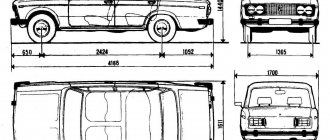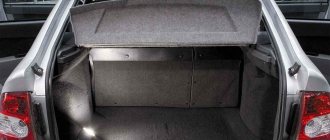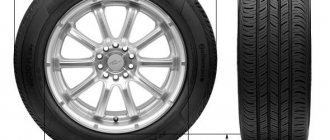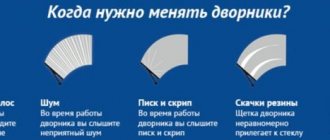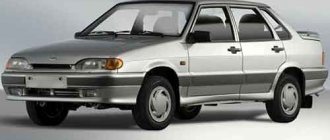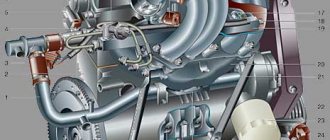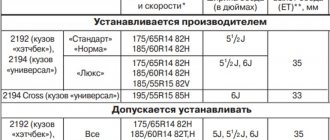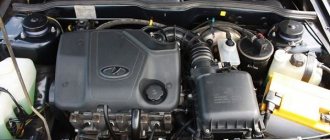| Modification | Maximum torque, N*m | Engine make |
| 1.5 l, 68 hp, gasoline, manual transmission, front-wheel drive | 103 | -2103 |
| 1.5 l, 70 hp, gasoline, manual transmission, front-wheel drive | 104 | -21083 |
| 1.5 l, 76 hp, gasoline, manual transmission, front-wheel drive | 106 | -21083 |
| 1.5 l, 78 hp, gasoline, manual transmission, front-wheel drive | 115 | -2111 |
| 1.6 l, 80 hp, gasoline, manual transmission, front-wheel drive | 120 | -21114 |
| 1.6 l, 81 hp, gasoline, manual transmission, front-wheel drive | 120 | -11183 |
History [edit | edit code]
VAZ-2115 became the first-born of the line codenamed “Samara-2”, after the Sputnik/Samara family, which became the most modified model of this family. This fact of modernization is confirmed by the fact that the VAZ-2115 has significantly changed the rear part of the car body. Namely the trunk lid, lighting devices. No similar transformations followed on the VAZ-2113 and VAZ-2114 cars. VAZ-2115 is a restyled model of VAZ-21099. The new model differed from its predecessor in the rounded shape of the hood and front fenders, trunk lid, new front and rear optics, bumpers painted in body color, trunk spoiler with an additional brake light, door sill fairings, door moldings, as well as a new interior and upgraded electrical equipment.
Initially, plans to modernize the Samara-2 line included changing not only the exterior of the body and trim, but also improving the suspension, transmission and braking system. However, ultimately, all these nodes were borrowed from the Samara-1 family without any significant changes. This made it possible to achieve a high degree of unification with the “ninth” family. The car received a more streamlined shape, thanks to which the angular outlines of the exterior, characteristic of the first generation Samar, are a thing of the past. Loading things into the trunk became much more convenient - now the loading height was at the level of the bumper. And a more advanced injection engine made it possible to develop more power, consume less fuel and warm up faster. In addition, the electronic engine control system monitored the level of exhaust toxicity.
Electrical equipment has also been improved. Now the car package included: electric windows for the front doors, as well as fog lights and heated seats (only on “luxury” versions). All versions were equipped with an on-board monitoring system, which made it possible to monitor the proper operation of lamps, oil level, brake pad wear, and the level of coolant and washer fluids directly from the driver’s seat.
Pilot modifications of the VAZ-2115 (from 1997 to 2000) were equipped with VAZ-21083 carburetor engines with a displacement of 1499 cm³ and a power of 71.6 liters. With. and “high panel” from Samara-1. Since 2000, when the car was launched into mass production, they began to install the then new VAZ-2111 engines with distributed fuel injection, a displacement of 1499 cm³ and a power of 77.8 hp. With. And since 2007, the VAZ-2111 engine was replaced by a newer, improved, injection engine VAZ-11183, with a displacement increased to 1596 cm³ and a power of 80.9 liters. With.
At first, the “related” cars VAZ-21099 and VAZ-2115 were produced at the plant in parallel, until in 2004 the “fifteenth” model completely replaced the VAZ-21099.
In 2007, the bumpers and side moldings began to be painted completely in color (without the gray stripe).
In 2008, the VAZ-2115 underwent cosmetic changes in its appearance in order to better meet the criteria of modern automotive fashion. So, for example, the old wide molding on the car doors, painted gray from the factory, gave way to new, narrow moldings in body color (popularly called “euro-molding”), which nevertheless did not look very harmonious, given the unchanged design bumpers.
Modernization
Whatever one may say, after several years of operation, even the most elegant car wants to be modernized. Automakers have long understood this, periodically introducing restylings and tuners making changes on their own.
Regarding the 15th model, many attempts at modernization were carried out at the amateur level. Some images of such tuned cars have every right to be called masterpieces, others, to put it mildly, are not impressive.
When the car's mileage reaches 50 thousand km, it's time to think about the suspension. Tuners recommend upgrading it first, as one of the weakest areas.
Over time, the reaction is no longer the same as before, when even on the icy road 2115 confidently passed through flat sections and turns. Now the rear of the car begins to toss from side to side, and the acceleration dynamics and handling are no longer the same.
The second, no less important note relates to the comfort of the car. Over time, the already frail sound insulation completely wears out. Everything starts to creak, including the rear parcel shelf.
Modernization also concerns the introduction of various options. To be honest, almost all VAZ car models reach the end user as “semi-finished products”. There is no competent anti-corrosion treatment of the body, there are no required comfort and safety parameters.
Here are the activities that are usually carried out, such as tuning and modernization on the 15th model:
- Installation of lockers and protection of the power unit crankcase;
- Replacement of sedan door and trunk locks with new, silent ones;
- Replacement of covers;
- Modernization of disks by installing new cast ones;
- Noise insulation and anti-creak treatment of various parts of the body, necessarily the roof and doors;
- Body painting and anti-corrosion treatment of the floor and other components most susceptible to corrosion;
- Installation of body reinforcement (struts);
- Replacing bumpers;
- Replacement of wing and spoilers;
- Remodeling doors and much more.
Painting
Painting has a longer history than the car itself. At least if you mean a paint gun. Modern tools are made at the highest level and make it easy and quick to paint a part or the entire body in the appropriate color.
Note that small scratches on the paintwork of the 15th model can be easier to remove by polishing. But if they are too deep and reach the ground or metal, you have to paint them.
As you know, painting can be carried out in 2 ways: partially, when the parts are painted with a transition, or completely.
Transition painting is applicable only in cases where one or another body section is being restored. This method has both advantages and disadvantages.
Note. In particular, with this method, body parts will not need to be dismantled, and therefore the structure will not be damaged. On the other hand, partial painting cannot guarantee the long-lasting effect of paintwork as much as complete painting.
It was written above about the pistol, but you can paint the 15th model in your garage using a spray can. But this method has many disadvantages:
- The spray can has an uneven spray, which significantly complicates painting (an overly saturated jet causes smudges);
- It is difficult to choose the appropriate color of paint sold in cans;
- Spray paint fades faster over time (such paint protects the surface less well).
Advice. If, however, you chose the spray can painting method, it is recommended to apply thin layers, keeping the spray can as far as possible from the body part.
Example of painting a rusty part
Let's say that this is the wing of the 15th VAZ model:
- Wash the car completely;
- Get rid of rust by sanding the part with coarse sandpaper and applying a degreaser;
- Restore the geometric dimensions of the part by applying layers of putty.
Attention. If the body part is subject to frequent vibrations, then ordinary putty will not work. You need to choose one with aluminum particles.
Regarding the application of putty:
- It must first be properly diluted with the hardener, doing this in small portions (the mixture dries quickly);
- You need to apply it directly to the surface, remembering that the putty dries for about a quarter of an hour if the room temperature is at least 20 degrees.
Read also: Solaris hatchback trunk size
We continue the painting stage:
- After the putty has dried, you need to start cleaning (treating the surface with sandpaper until the part becomes smooth);
- We apply the first layer of primer, which will protect the part from corrosion and guarantee the durability of the paintwork.
Note. When choosing a primer, you need to pay attention to its consistency with the color of the car’s paint. So, if the car is painted black, the primer should be of some dark shade; if it is silver, it is advisable to select a light shade.
More on primer:
- It is advisable that it be applied using special equipment and tools (spray gun, compressor, respirator, etc.);
- Before applying primer, it is recommended to cover the car with a special film or, in extreme cases, paper;
- It is advisable to apply the primer in two layers, first degreasing the surfaces.
- After the soil has dried, it must be treated with 800-grit sandpaper;
- We now prepare the room for painting, removing all the dust around with water (we cover all parts of the car except the wing);
- We apply the paint in several layers, leaving each layer to dry for 1 minute (as a rule, after the 3rd layer the wing will already be what it needs);
- We wait for 15 minutes to dry completely, and then coat it with varnish.
Advice. Before applying the varnish, it is recommended to go over the paint with a clean cloth, since the varnish itself is very sensitive to remaining grains of sand (even if they are microscopic).
The varnish is also applied in two layers, allowing it to dry for 2 minutes.
Body reinforcement
This modernization helps to significantly simplify the operation of the machine. After such strengthening, cornering on VAZ models will be more confident, even at high speed. In addition, and more importantly, the degree of deformation is reduced.
It is recommended to install spacers from well-known manufacturing companies, but it is better to avoid products made in a handicraft manner.
Installation will not create any difficulties. It will be enough to buy the part, and then install and secure it accordingly.
How much does VAZ 2115 weigh?
The curb weight of a vehicle is the weight of a vehicle with standard equipment, various consumables (oil, coolant, etc.), but minus the weight of passengers, driver and luggage.
Dry weight is equal to curb weight, but only without fuel, some equipment and consumables. That is, this is the mass of an unloaded vehicle without fuel.
The permissible gross weight is the weight of the maximum loaded vehicle provided by the manufacturer. This is sometimes called the maximum permissible mass. It is better not to go beyond the limits of this indicator, unless, of course, you want your car to last for a very long time. The increased load has a negative impact on the car body and suspension parts.
Malfunctions
| FAULTS | CAUSES AND REMEDIES |
| The engine does not start or runs with detonation and strong vibrations. | Injection system failure. It is necessary to open the engine, clean the injectors and check their functionality. |
| The engine is shaking, the idle speed is floating. | The throttle sensor or idle speed control has failed. Repairs are made only after a thorough diagnosis and consist of replacing the failed element. |
| The engine takes a long time to warm up or does not reach operating temperature at all. | The thermostat failed, which closed the circulation of liquid along a large circuit. The repair consists of replacing the thermostat. |
| The appearance of an extraneous knocking sound in the engine under load. | Valves are knocking and require adjustment. Repair in this case involves opening the engine and adjusting the valve clearance. |
How much does the VAZ weigh?
Perhaps one of the most popular cars in the post-Soviet space was, is and remains the VAZ. This car has captivated many generations. However, how did it all begin? When was the first VAZ car produced and how much did it weigh? You will learn the answers to these and other questions from this article.
The first VAZ car was produced by the Volzhsky Automobile Plant on April 19, 1970. The make of this car was VAZ-2101 Zhiguli. Its production was carried out according to the analogue of the Fiat concern. Moreover, VAZ owes its appearance to this particular brand of Fiat 124, produced in 1966. Here, in fact, is it:
As a result of some design improvements, the first domestic car, the VAZ 2101 of 1970, was produced:
The weight of this car was 955 kg. Moreover, of this mass the engine weighed 114 kg.
It has not lost its popularity to this day. In 2000, it was recognized as the best car among eighty thousand car enthusiasts surveyed in the CIS countries and Russia. It was named the best car of the century, VAZ 2101. At the time of its production, it was considered the most comfortable, reliable and modern domestic car. Its presence was a sign of wealth and prosperity!
But the Volzhsky Automobile Plant did not stop there. He created entire collections of this car. Each of them differed in its configuration, as well as its total weight. Therefore, now we will compare some VAZ models by their weight.
- VAZ 2102 has a weight of 1010 kg .
- VAZ 2103 has a weight of 965 kg .
- VAZ 2104 has a weight of 1020 kg .
- VAZ 2105 has a weight of 1060 kg .
- VAZ 2106 has a weight of 1045 kg .
- VAZ 2107 weighs 1049 kg .
- VAZ 2108 weighs 945 kg .
- VAZ 2109 weighs 915 kg .
- VAZ 2110 has a weight of 1020 kg .
- VAZ 2111 has a weight of 1055 kg .
- VAZ 2112 has a weight of 1060 kg .
- VAZ 2113 weighs 975 kg .
- VAZ 2114 weighs 985 kg .
- VAZ 2115 has a weight of 1000 kg .
- VAZ 2116 weighs 1276 kg .
- VAZ 2117 has a weight of 1110 kg .
- VAZ 2118 has a weight of 1110 kg .
- VAZ 2119 has a weight of 1110 kg .
- VAZ 2120 has a weight of 1110 kg .
- VAZ 2121 has a weight of 1550 kg .
- VAZ 2122 has a weight of 1122 kg .
- VAZ 2123 has a weight of 1300 kg .
But this is the total weight of a VAZ car. As for some parts of the car, the weight of, for example, a VAZ 2106 can be decomposed as follows:
- The weight of the engine with equipment is 140 kilograms .
- The weight of the gearbox is 26 kilograms .
- The weight of the square shaft is 10 kilograms .
- The weight of the rear axle is 52 kilograms .
- Radiator weight – 7 kilograms .
- Body weight – 280 kilograms .
On average, the weight of all components of a VAZ car has approximately the same mass. Throughout the entire period of existence of this car, quite interesting facts have been recorded that simply cannot be ignored. It’s hard to imagine that a car weighing an average of 1 ton is very popular.
So, the VAZ 2121 Niva car is not only the most popular throughout the USSR, but also the most exported. Just imagine, this model was produced in 1.8 million cars. And of this amount, 500,000 were sold to more than 100 countries. As we remember, the weight of the VAZ 2121 is 1550 kilograms . This means that over the entire period, 775,000,000 kilograms of this car were sold! Also, this particular model of all Soviet cars was driven in Japan. As for the design of the VAZ 2108, it was developed by the currently well-known company Porshe. Its engine weighs 127.3 kilograms . This became necessary due to the fact that the demand for this brand of car was greatly reduced. For this reason, they decided to modernize it.
Moreover, the VAZ car became more popular because the Lada car was the first car of the famous Formula 1 racer - Kimi Raikkonen. His father loved this car extremely much for its reliability.
So, we learned that each VAZ car model has its own separate weight. But throughout the history of its existence and production, it has not undergone major changes.
Tuning
There are several possible ways to increase engine power. Let's talk about these tuning options in more detail:
- Chip tuning of the VAZ 2115 engine will not allow you to obtain any noticeable effect. Even by replacing the engine control unit, the car owner will be able to get 3-5 horsepower, the increase of which will be almost imperceptible.
- Deep engineering tuning of VAZ 2115 engines, which involves replacing the camshaft and other power elements, will increase the engine power to 85 horsepower. Such an increase of 10 horses will already be noticeable, and the car will accelerate faster, especially from low revs.
- Replacing the throttle body and exhaust will increase power to 95 horsepower.
- If the engine power limit of 100 horses is important to you, then you need to install lightweight valves, mill the cylinder head and replace the intake manifold. A car with such a tuned engine will accelerate 1-2 seconds faster than with a basic 78-horsepower engine. A further increase in power by replacing internal power parts will not allow you to obtain the desired horsepower, and the service life of the motor is significantly reduced.
- An alternative way to increase the power of a VAZ 2115 engine is to install a compressor with a pressure of about 0.5 bar. If the compressor is properly configured, the engine power will be about 120 horsepower. At the same time, when resorting to such tuning, the car owner must be prepared to reduce the service life of the engine, which may require appropriate major repairs after only 75-100 thousand kilometers.
VAZ 2115 Fifteenth technical specifications
Performance characteristics of the VAZ 2115 fifteenth sedan
Maximum speed: 170 km/h Acceleration time to 100 km/h: 14 sec Fuel consumption per 100 km in the city: 10 l Fuel consumption per 100 km on the highway: 5.7 l Fuel consumption per 100 km in the combined cycle: 7.3 l Fuel tank volume: 43 l Vehicle curb weight: 970 kg Permissible gross weight: 1395 kg Tire size: 175/70 R13
Engine characteristics
Location: front, transverse Engine capacity: 1500 cm3 Engine power: 78 hp Number of revolutions: 5400 Torque: 115/3000 N*m Power system: Distributed injection Turbocharging: no Gas distribution mechanism: OHC Cylinder arrangement: In-line Number of cylinders: 4 Cylinder diameter: 82 mm Piston stroke: 71 mm Compression ratio: 9.9 Number of valves per cylinder: 2 Recommended fuel: AI-95
Brake system
Front brakes: Disc Rear brakes: Drum ABS: yes
Steering
Power steering: no Steering type: Rack and pinion
Transmission
Drive: Front Number of gears: manual gearbox - 5 Gear ratio of the main pair: 3.9
Suspension
Front suspension: Shock absorber Rear suspension: Coil spring
Body
Body type: sedan Number of doors: 4 Number of seats: 5 Vehicle length: 4330 mm Vehicle width: 1620 mm Vehicle height: 1415 mm Wheelbase: 2460 mm Front track: 1400 mm Rear track: 1370 mm Ground clearance (clearance): 160 mm Trunk volume: 427 l
Production
Year of manufacture: from 1997 to 2012
Article rating:
(votes: 1 , average rating: 2.00 out of 5)
Save to:
How much does VAZ 2115 weigh? Link to main publication
Description
The VAZ 2115 engine was developed on the basis of engine modification 21083. The only differences are the presence of an injector, which replaced the aging carburetor, a modified camshaft and a floating connecting rod pin.
- In total, the new engine turned out to be 6 horsepower more powerful than its predecessor. At the same time, the power unit has become more responsive and provides confident traction at various speeds. Like its predecessor, this engine has a belt drive, which somewhat complicates maintenance work.
- If the belt breaks, the valves do not bend, which eliminates the need for complex repairs. The motor itself turned out to be quite reliable and has a service life of 150 thousand kilometers. When following all service recommendations and careful operation, mileages of 200 and 300 thousand kilometers are not uncommon.
- The four-cylinder engine is cast from a durable cast iron alloy, which improves temperature resistance. It is practically not subject to overheating, which allows you to operate the car in difficult conditions and under maximum loads.
- In general, impressions of the VAZ 2115 engine are positive. It is moderately powerful, reliable and easy to maintain. However, you shouldn't expect miracles from him. From 1.5 liters of volume, VAZ engineers managed to extract only 78 horsepower. Whereas engines of similar volume in modern cars produce at least 100 horsepower.
- The average fuel consumption, which is 7.3 liters in mixed mode, also does not shine. This engine is also not without characteristic breakdowns, which, although not critical, can cause a lot of problems for the car owner.
Main competitors
The main competitors from domestic brands were Lada-Granta and VAZ 2111. The “Eleventh” model has a spacious interior and a large luggage compartment, which determined its advantage.
Reviews about the fifteenth model are mostly positive. Owners are satisfied with: stability on the road, ease of maintenance and a fairly low price. But the small interior is not very comfortable, especially for transporting passengers in the back seat.
The car is economical, comfortable, and stable on the road. Quite frisky. If you invest a little money in tuning, it will have no equal. It can even compete with the Priora, having less weight than it. The instrument panel is easy to read. The steering wheel turns easily. There was a desire to install an EUR, I went to the rocking chair - now I don’t need it. The trunk is roomy and the load capacity is excellent - I loaded it with 4 bags of cement, the mudguards were plowing, but I got there fine.
Oleg. Russia.
Acceleration to 100 in Lada 2115 Samara
Acceleration time to 100 km/h Lada 2115 Samara - from 13 to 14 seconds.
Acceleration to 100 in Lada 2115 Samara 1997, sedan, 1st generation
| Modification | Acceleration to 100 km/h |
| 1.5 l, 70 hp, gasoline, manual transmission, front-wheel drive | 13 |
| 1.6 l, 80 hp, gasoline, manual transmission, front-wheel drive | 13 |
| 1.6 l, 81 hp, gasoline, manual transmission, front-wheel drive | 13 |
| 1.5 l, 68 hp, gasoline, manual transmission, front-wheel drive | 13.2 |
| 1.5 l, 76 hp, gasoline, manual transmission, front-wheel drive | 13.2 |
| 1.5 l, 78 hp, gasoline, manual transmission, front-wheel drive | 14 |
